9.3E: Exercises
- Page ID
- 120512
\( \newcommand{\vecs}[1]{\overset { \scriptstyle \rightharpoonup} {\mathbf{#1}} } \)
\( \newcommand{\vecd}[1]{\overset{-\!-\!\rightharpoonup}{\vphantom{a}\smash {#1}}} \)
\( \newcommand{\id}{\mathrm{id}}\) \( \newcommand{\Span}{\mathrm{span}}\)
( \newcommand{\kernel}{\mathrm{null}\,}\) \( \newcommand{\range}{\mathrm{range}\,}\)
\( \newcommand{\RealPart}{\mathrm{Re}}\) \( \newcommand{\ImaginaryPart}{\mathrm{Im}}\)
\( \newcommand{\Argument}{\mathrm{Arg}}\) \( \newcommand{\norm}[1]{\| #1 \|}\)
\( \newcommand{\inner}[2]{\langle #1, #2 \rangle}\)
\( \newcommand{\Span}{\mathrm{span}}\)
\( \newcommand{\id}{\mathrm{id}}\)
\( \newcommand{\Span}{\mathrm{span}}\)
\( \newcommand{\kernel}{\mathrm{null}\,}\)
\( \newcommand{\range}{\mathrm{range}\,}\)
\( \newcommand{\RealPart}{\mathrm{Re}}\)
\( \newcommand{\ImaginaryPart}{\mathrm{Im}}\)
\( \newcommand{\Argument}{\mathrm{Arg}}\)
\( \newcommand{\norm}[1]{\| #1 \|}\)
\( \newcommand{\inner}[2]{\langle #1, #2 \rangle}\)
\( \newcommand{\Span}{\mathrm{span}}\) \( \newcommand{\AA}{\unicode[.8,0]{x212B}}\)
\( \newcommand{\vectorA}[1]{\vec{#1}} % arrow\)
\( \newcommand{\vectorAt}[1]{\vec{\text{#1}}} % arrow\)
\( \newcommand{\vectorB}[1]{\overset { \scriptstyle \rightharpoonup} {\mathbf{#1}} } \)
\( \newcommand{\vectorC}[1]{\textbf{#1}} \)
\( \newcommand{\vectorD}[1]{\overrightarrow{#1}} \)
\( \newcommand{\vectorDt}[1]{\overrightarrow{\text{#1}}} \)
\( \newcommand{\vectE}[1]{\overset{-\!-\!\rightharpoonup}{\vphantom{a}\smash{\mathbf {#1}}}} \)
\( \newcommand{\vecs}[1]{\overset { \scriptstyle \rightharpoonup} {\mathbf{#1}} } \)
\( \newcommand{\vecd}[1]{\overset{-\!-\!\rightharpoonup}{\vphantom{a}\smash {#1}}} \)
Exercises
In Exercises 1 - 6, solve the given system of nonlinear equations. Sketch the graph of both equations on the same set of axes to verify the solution set.
- \(\left\{\begin{aligned}
x^{2}-y &=4 \\
x^{2}+y^{2} &=4
\end{aligned}\right.\) - \(\left\{\begin{array}{r}
x^{2}+y^{2}=4 \\
x^{2}-y=5
\end{array}\right.\) - \(\left\{\begin{aligned}
x^{2}+y^{2} &=16 \\
16 x^{2}+4 y^{2} &=64
\end{aligned}\right.\) - \(\left\{\begin{array}{rrr}
x^{2}+y^{2} & =&16 \\
9 x^{2}-16 y^{2} & =&144
\end{array}\right.\) - \(\left\{\begin{array}{rlr}
x^{2}+y^{2} & =&16 \\
\frac{1}{9} y^{2}-\frac{1}{16} x^{2} & =&1
\end{array}\right.\) - \(\left\{\begin{array}{rlr}
x^{2}+y^{2} & = & 16 \\
x-y & = & 2
\end{array}\right.\)
In Exercises 7 - 15, solve the given system of nonlinear equations. Use a graph to help you avoid any potential extraneous solutions.
- \(\left\{\begin{aligned}
x^{2}-y^{2} &=1 \\
x^{2}+4 y^{2} &=4
\end{aligned}\right.\) - \(\left\{\begin{aligned}
\sqrt{x+1}-y &=0 \\
x^{2}+4 y^{2} &=4
\end{aligned}\right.\) - \(\left\{\begin{aligned}
x+2 y^{2} &=2 \\
x^{2}+4 y^{2} &=4
\end{aligned}\right.\) - \(\left\{\begin{aligned}
(x-2)^{2}+y^{2} &=1 \\
x^{2}+4 y^{2} &=4
\end{aligned}\right.\) - \(\left\{\begin{array}{rlr}
x^{2}+y^{2} & =&25 \\
y-x & =&1
\end{array}\right.\) - \(\left\{\begin{aligned}
x^{2}+y^{2} &=25 \\
x^{2}+(y-3)^{2} &=10
\end{aligned}\right.\) - \(\left\{\begin{array}{l}
y=x^{3}+8 \\
y=10 x-x^{2}
\end{array}\right.\) - \(\left\{\begin{array}{l}
x^{2}-x y=8 \\
y^{2}-x y=8
\end{array}\right.\) - \(\left\{\begin{array}{rlr}
x^{2}+y^{2} & = & 25 \\
4 x^{2}-9 y & = & 0 \\
3 y^{2}-16 x & = & 0
\end{array}\right.\) - A certain bacteria culture follows the Law of Uninhibited Growth. After 10 minutes, there are 10,000 bacteria. Five minutes later, there are 14,000 bacteria. How many bacteria were present initially? How long before there are 50,000 bacteria?
Consider the system of nonlinear equations below
\(\left\{\begin{array}{l}
\frac{4}{x}+\frac{3}{y}=1 \\
\frac{3}{x}+\frac{2}{y}=-1
\end{array}\right.\)
If we let \(u=\frac{1}{x}\) and \(v=\frac{1}{y}\) then the system becomes
\(\left\{\begin{array}{lr}
4 u+3 v&=&1 \\
3 u+2 v&=&-1
\end{array}\right.\)
This associated system of linear equations can then be solved using any of the techniques presented earlier in the chapter to find that \(u = −5\) and \(v = 7\). Thus \(x=\frac{1}{u}=-\frac{1}{5}\) and \(y=\frac{1}{v}=\frac{1}{7}\).
We say that the original system is linear in form because its equations are not linear but a few substitutions reveal a structure that we can treat like a system of linear equations. Each system in Exercises 17 - 19 is linear in form. Make the appropriate substitutions and solve for \(x\) and \(y\).
- \(\left\{\begin{array}{rrr}
4 x^{3}+3 \sqrt{y}= & 1 \\
3 x^{3}+2 \sqrt{y}= & -1
\end{array}\right.\) - \(\left\{\begin{aligned}
4 e^{x}+3 e^{-y} &=1 \\
3 e^{x}+2 e^{-y} &=-1
\end{aligned}\right.\) - \(\left\{\begin{array}{lr}
4 \ln (x)+3 y^{2}&=&1 \\
3 \ln (x)+2 y^{2}&=&-1
\end{array}\right.\) - Solve the following system \[\left\{\begin{aligned}
x^{2}+\sqrt{y}+\log _{2}(z) &=6 \\
3 x^{2}-2 \sqrt{y}+2 \log _{2}(z) &=5 \\
-5 x^{2}+3 \sqrt{y}+4 \log _{2}(z) &=13
\end{aligned}\right.\nonumber\]
In Exercises 21 - 26, sketch the solution to each system of nonlinear inequalities in the plane.
- \(\left\{\begin{aligned}
x^{2}-y^{2} & \leq 1 \\
x^{2}+4 y^{2} & \geq 4
\end{aligned}\right.\) - \(\left\{\begin{aligned}
x^{2}+y^{2} &<25 \\
x^{2}+(y-3)^{2} & \geq 10
\end{aligned}\right.\) - \(\left\{\begin{aligned}
(x-2)^{2}+y^{2} &<1 \\
x^{2}+4 y^{2} &<4
\end{aligned}\right.\) - \(\left\{\begin{array}{rrr}
y & > & 10 x-x^{2} \\
y & < & x^{3}+8
\end{array}\right.\) - \(\left\{\begin{aligned}
x+2 y^{2} &>2 \\
x^{2}+4 y^{2} & \leq 4
\end{aligned}\right.\) - \(\left\{\begin{aligned}
x^{2}+y^{2} & \geq 25 \\
y-x & \leq 1
\end{aligned}\right.\) - Systems of nonlinear equations show up in third semester Calculus in the midst of some really cool problems. The system below came from a problem in which we were asked to find the dimensions of a rectangular box with a volume of 1000 cubic inches that has minimal surface area. The variables \(x\), \(y\) and \(z\) are the dimensions of the box and λ is called a Lagrange multiplier. With the help of your classmates, solve the system.5 \[\left\{\begin{aligned}
2 y+2 z &=\lambda y z \\
2 x+2 z &=\lambda x z \\
2 y+2 x &=\lambda x y \\
x y z &=1000
\end{aligned}\right.\nonumber\] - The polynomial \(p(x)=x^{4}+4\) can be factored into the product linear and irreducible quadratic factors. In this exercise, we present a method for obtaining that factorization.
- Show that \(p\) has no real zeros.
- Because \(p\) has no real zeros, its factorization must be of the form \(\left(x^{2}+a x+b\right)\left(x^{2}+c x+d\right)\) where each factor is an irreducible quadratic. Expand this quantity and gather like terms together.
- Create and solve the system of nonlinear equations which results from equating the coefficients of the expansion found above with those of \(x^{4}+4\). You should get four equations in the four unknowns \(a\), \(b\), \(c\) and \(d\). Write p(x) in factored form.
- Factor \(q(x)=x^{4}+6 x^{2}-5 x+6\).
Answers
- \((\pm 2,0),(\pm \sqrt{3},-1)\)
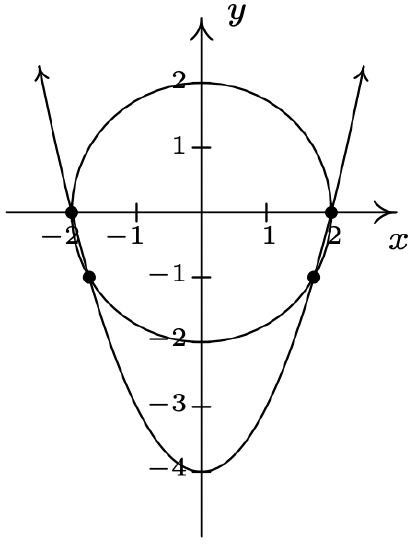
- No solution
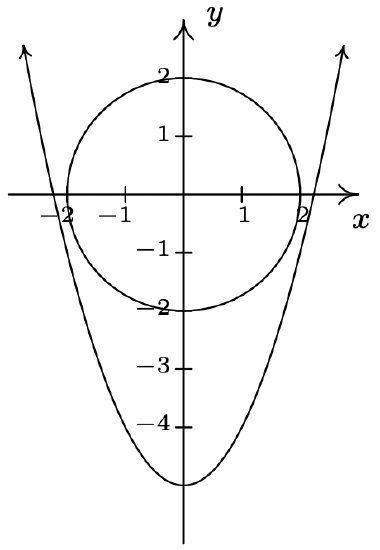
- \((0, \pm 4)\)
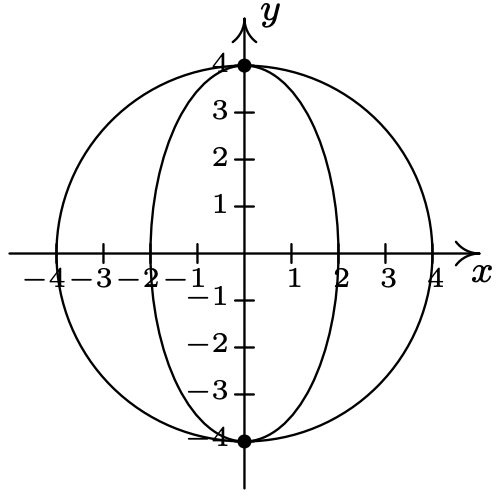
- \((\pm 4,0)\)
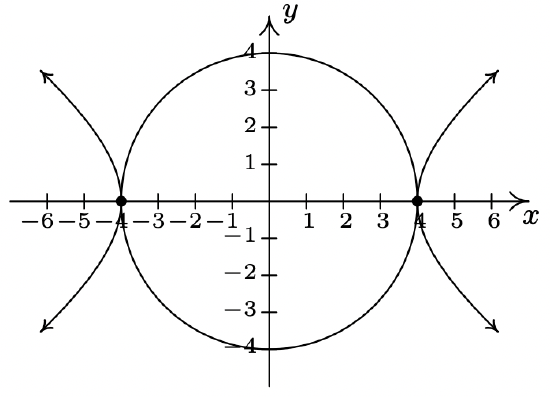
- \(\left(\pm \frac{4 \sqrt{7}}{5}, \pm \frac{12 \sqrt{2}}{5}\right)\)
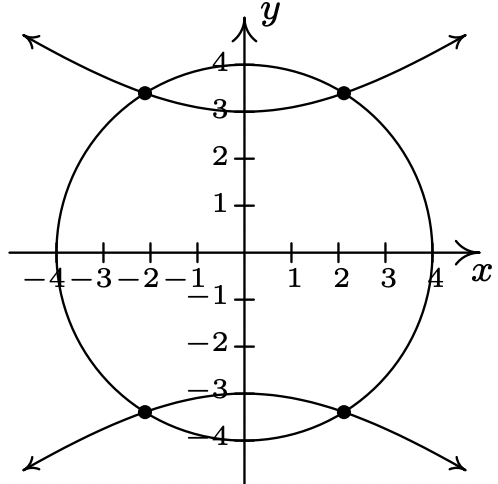
- \((1+\sqrt{7},-1+\sqrt{7}),(1-\sqrt{7},-1-\sqrt{7})\)
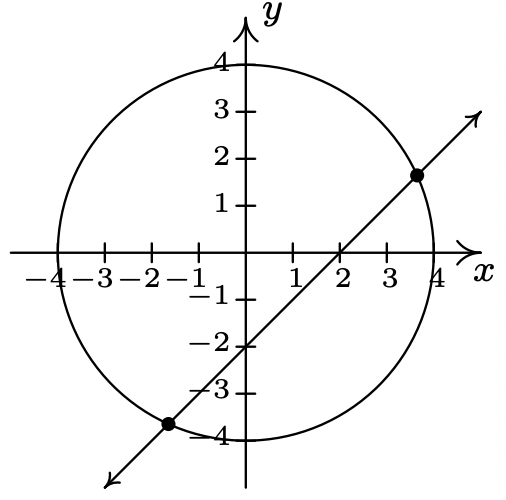
- \(\left(\pm \frac{2 \sqrt{10}}{5}, \pm \frac{\sqrt{15}}{5}\right)\)
- \((0,1)\)
- \((0, \pm 1),(2,0)\)
- \(\left(\frac{4}{3}, \pm \frac{\sqrt{5}}{3}\right)\)
- \((3,4),(-4,-3)\)
- \((\pm 3,4)\)
- \((-4,-56),(1,9),(2,16)\)
- \((-2,2),(2,-2)\)
- \((3,4)\)
- Initially, there are \(\frac{250000}{49} \approx 5102\) bacteria. It will take \(\frac{5 \ln (49 / 5)}{\ln (7 / 5)} \approx 33.92\) minutes for the colony to grow to 50,000 bacteria.
- \((-\sqrt[3]{5}, 49)\)
- No solution
- \(\left(e^{-5}, \pm \sqrt{7}\right)\)
- (1, 4, 8), (−1, 4, 8)
-
\(\left\{\begin{aligned}
x^{2}-y^{2} & \leq 1 \\
x^{2}+4 y^{2} & \geq 4
\end{aligned}\right.\)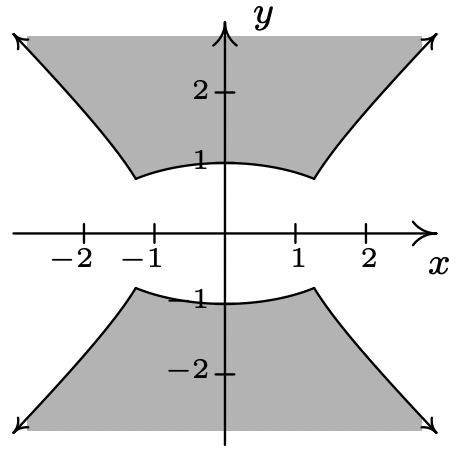
-
\(\left\{\begin{aligned}
x^{2}+y^{2} &<25 \\
x^{2}+(y-3)^{2} & \geq 10
\end{aligned}\right.\)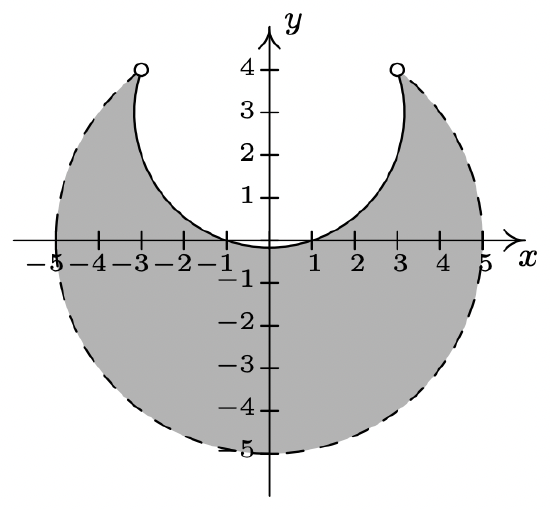
-
\(\left\{\begin{aligned}
(x-2)^{2}+y^{2} &<1 \\
x^{2}+4 y^{2} &<4
\end{aligned}\right.\)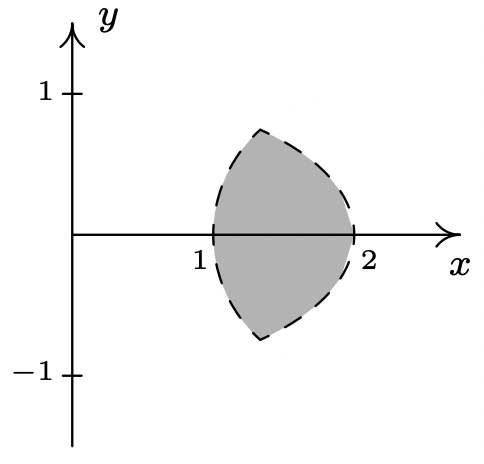
-
\(\left\{\begin{array}{lr}
y> & 10 x-x^{2} \\
y< & x^{3}+8
\end{array}\right.\)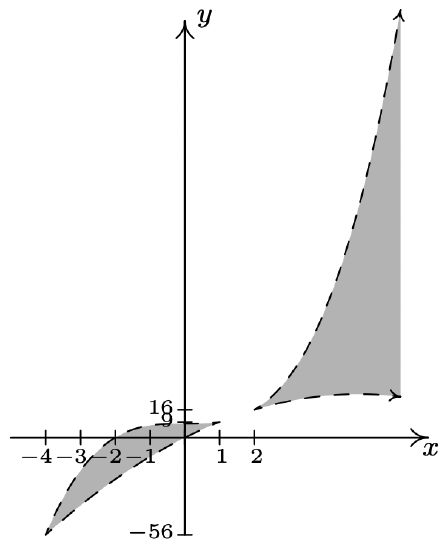
-
\(\left\{\begin{aligned}
x+2 y^{2} &>2 \\
x^{2}+4 y^{2} & \leq 4
\end{aligned}\right.\)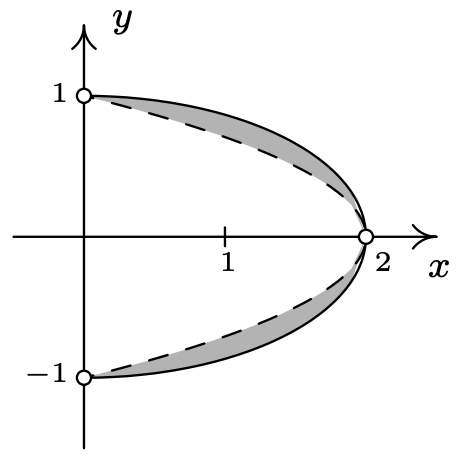
-
\(\left\{\begin{aligned}
x^{2}+y^{2} & \geq 25 \\
y-x & \leq 1
\end{aligned}\right.\)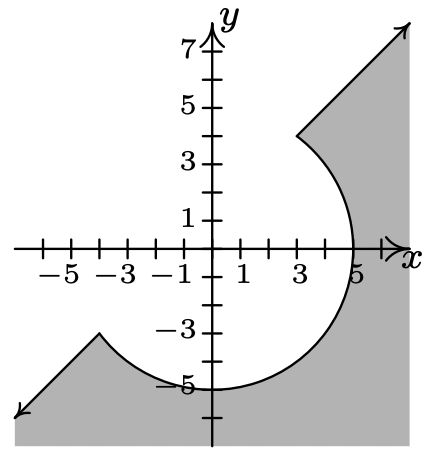
- \(x=10, y=10, z=10, \lambda=\frac{2}{5}\)
- \(\text { (c) } x^{4}+4=\left(x^{2}-2 x+2\right)\left(x^{2}+2 x+2\right)\)
- \(x^{4}+6 x^{2}-5 x+6=\left(x^{2}-x+1\right)\left(x^{2}+x+6\right)\)

